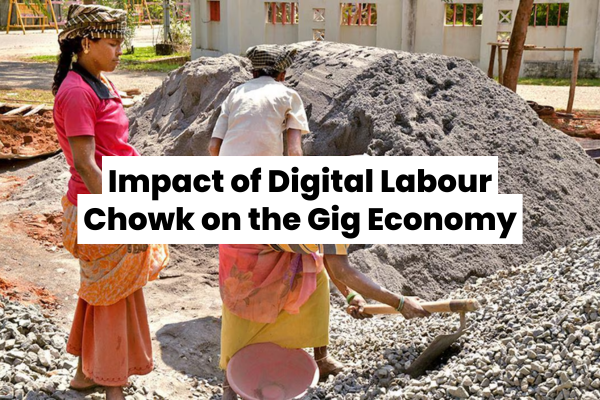Physical Address
Introduction

In the bustling marketplaces of cities around the world, traditional Labour Chowks have long served as gathering points where daily wage workers and employers meet. These informal setups, however, are increasingly being replaced by Digital Labour Chowks (DLCs) that leverage technology to bring together gig workers and job opportunities online. This shift is part of the broader transformation of the employment landscape through the gig economy, which emphasizes flexibility, short-term contracts, and freelance work. But what does this mean for the future of employment?
If you want to know more about Gig Economy Please visit: https://hrforecast.com/what-is-the-gig-economy-and-why-is-it-the-future-of-work/
The Traditional Labour Chowk

What is a Labour Chowk?
A Labour Chowk is an informal gathering point where daily wage workers assemble, typically early in the morning, to seek temporary employment. These workers, who range from unskilled laborers to skilled tradespeople like masons, electricians, and carpenters, offer their services for short-term projects. Labour Chowks are commonly found in urban areas where construction, repair, and maintenance work are frequent. Employers visit these locations to hire workers on the spot, negotiating wages and job terms face-to-face. While convenient, the lack of formal structure often leads to uncertainty and inconsistencies in wages and job availability.
Challenges Faced by Workers
Workers at traditional Labour Chowks face a number of difficulties. The first is the lack of job security, as employment opportunities are not guaranteed, and competition for jobs can be intense. Negotiations for wages are often informal and arbitrary, leading to inconsistent pay, sometimes lower than what is fair. Additionally, workers are often exposed to exploitation, with little recourse for complaints or grievances. There’s also a lack of health benefits, safety regulations, or formal contracts. This instability leaves workers vulnerable, with no assurances of stable income or working conditions, contributing to their overall insecurity.
Limitations for Employers
For employers, hiring workers from a traditional Labour Chowk comes with its own set of challenges. Since there is no formal vetting or qualification process, the quality of workers can vary significantly. Employers often have to spend considerable time finding reliable and skilled workers, which leads to inefficiency. Negotiating wages on the spot also adds to the uncertainty and can sometimes result in disagreements. Moreover, without a review or rating system, employers lack any assurance of the worker’s reliability or past performance, making it difficult to hire with confidence. These limitations often lead to delays and inconsistent results.
Understanding Digital Labour Chowk

Definition and Concept
The Digital Labour Chowk (DLC) is a modern, tech-enabled platform that revolutionizes how daily wage workers and employers connect. By moving from physical street corners to digital platforms, DLC addresses many challenges faced by both workers and employers in traditional labour chowks. Here’s an in-depth look at how it works and its impact:
Evolution from Physical to Digital Platforms
Historically, workers gathered in physical locations to offer their services to potential employers. With the advent of the internet and mobile technology, these interactions are now moving online. Platforms like TaskRabbit, Upwork, and Freelancer are modern-day digital equivalents that provide a virtual space for these exchanges.
Technological Advancements Leading to Digital Labour Chowk
The transition from traditional labour chowks to digital platforms is driven by technological advancements like smartphones, the internet, and user-friendly applications. Mobile technology plays a pivotal role, as it allows even the most basic mobile devices to access job opportunities through apps or websites. These platforms enable workers to create profiles, upload their skills, and receive notifications about job openings. For employers, the ability to search for workers by skill level, location, and ratings makes hiring much easier and faster. This shift also improves overall efficiency, allowing more people to find work without physically commuting to labour hubs.
Early Adopters and Pioneers of Digital Labour Chowk
Several pioneering platforms have led the digital labour movement. Companies like LabourNet, Lynk, and the Digital Labour Chowk itself saw the need for a structured, tech-driven approach to daily wage employment. They created systems where workers could register, upload certifications, and track job history. Early adopters saw immense value in the transparency these platforms offer. Workers, who previously relied on word-of-mouth or physical gatherings to find work, could now connect directly with employers from anywhere. These platforms also incorporated feedback mechanisms like ratings and reviews, which build trust and foster accountability between employers and workers.
How Digital Labour Chowk Works

Platforms and Apps
Digital Labour Chowk operates primarily through mobile apps and websites. Workers create profiles, listing their skills, experience, and location preferences. Employers can post job requirements, view worker profiles, and hire candidates based on skills, availability, and reviews. With real-time notifications, workers no longer need to wait at a physical location for job offers; instead, they can be alerted via their mobile devices when new opportunities arise.
User Experience for Workers
For workers, the digital transformation is a game-changer. Through DLC platforms, they can access multiple job opportunities without physically traveling to labour chowks, saving time and money. The digital platform provides transparency, ensuring fair wages as workers can see job details before accepting an offer. Workers can also choose jobs that match their skills and availability. Some platforms also offer training modules to help workers improve their skills, enhancing their employability and career prospects. Payments through digital wallets or bank transfers further ensure timely compensation, eliminating wage-related disputes.
User Experience for Employers
Employers benefit immensely from DLC platforms by having access to a larger pool of vetted, skilled workers. Instead of physically scouting for laborers at traditional chowks, employers can search for workers based on specific criteria, such as skill set, past reviews, and proximity. The integrated payment systems reduce risks associated with cash transactions, and the review and rating systems offer additional reliability. Employers can also plan ahead by posting job requirements in advance, allowing them to hire workers efficiently without the last-minute rush.
Benefits for Workers
Increased Job Opportunities
Digital Labour Chowk platforms open up a broader range of employment opportunities for workers. Workers can access job postings from different locations, including those outside their immediate vicinity. This increases their chances of securing consistent work and allows them to move between short-term contracts efficiently.
Fair Wages and Transparency
Traditional labour chowks often involved inconsistent wage negotiations. In contrast, DLC platforms offer clear job descriptions, including predefined wages, ensuring fairness. Workers can see payment terms before accepting jobs, leading to fewer disputes over compensation. This transparency is beneficial for both parties, creating a more equitable system.
Skill Development and Training
Many DLC platforms provide skill development programs, offering workers the opportunity to learn new skills and improve existing ones. This enhances their employability and opens up access to better-paying jobs. These programs are often accessible directly through the platform and focus on industry-relevant skills like construction, plumbing, and electrical work.
Benefits for Employers
Easier Access to a Diverse Workforce
With DLC platforms, employers gain access to a wide array of workers with various skill levels. They can search for specialized workers like electricians or masons or hire general laborers, all in one place. The convenience of searching by skills, location, and availability saves time and reduces the hassle of finding reliable workers.
Cost Efficiency
By streamlining the hiring process, Digital Labour Chowk platforms reduce costs associated with scouting and negotiating with workers. Employers can hire faster, avoid middlemen, and ensure they are paying fair wages without overpaying or underpaying for labour. This efficiency leads to reduced downtime and more effective project management.
The Gig Economy: An Overview

Definition and Key Characteristics
The gig economy refers to a labour market characterized by short-term, freelance, or contract-based work rather than permanent, full-time employment. Workers, often referred to as gig workers, are typically hired for specific projects or tasks through digital platforms like Uber, Upwork, or TaskRabbit. The gig economy offers flexibility for workers to choose their own hours and employers to hire on-demand. However, it also comes with challenges like job insecurity, lack of benefits, and inconsistent income. The gig economy is growing rapidly, driven by technology, remote work opportunities, and changing attitudes toward traditional employment.
Impact of Digital Labour Chowk on the Gig Economy

The gig economy offers several benefits to workers, such as flexibility in work hours, opportunities for additional income, and the freedom to choose projects that align with their skills and interests. For many, it provides a way to balance personal commitments while earning a living. However, it also presents challenges like a lack of job security, no access to benefits like health insurance or retirement plans, and fluctuating income. Gig workers are also responsible for their own taxes and often face difficulty in securing long-term financial stability due to the unpredictability of work availability.
Challenges and Concerns

Job Security and Stability
One of the main criticisms of the gig economy is the lack of job security and benefits for workers. Many gig workers face financial instability and lack protections enjoyed by full-time employees.
Regulatory and Legal Issues
The rise of gig work has outpaced regulations in many regions. This has led to legal challenges concerning worker classification, wages, and rights, prompting calls for updated labour laws.
Digital Divide and Accessibility
Not all workers have access to the internet or the necessary digital skills to use online platforms. This digital divide can exclude some from the benefits of Digital Labour Chowks.
Trust and Safety Issues
Ensuring the safety and trustworthiness of both workers and employers on digital platforms can be challenging. Platforms must implement robust verification and security measures to address these concerns.
Case Studies
Uber and the Gig Economy Transformation
Uber is a prime example of how the gig economy has transformed traditional industries. Launched in 2009, Uber revolutionized transportation by allowing individuals to offer ridesharing services through its app. This model created a new class of gig workers—drivers who can choose their own hours and work as much or as little as they want. Uber’s platform eliminates the need for traditional taxi services and connects drivers directly with customers.
For drivers, Uber offers flexibility and the ability to earn money on their own schedule. However, the model has been criticized for providing no benefits such as health insurance, paid leave, or retirement plans. Many drivers experience financial instability due to fluctuating demand and unpredictable working hours. Additionally, since drivers are classified as independent contractors, they don’t receive the same protections as full-time employees, leading to legal debates about labour rights. Despite these challenges, Uber has grown into a global company, expanding the gig economy model into other sectors like food delivery (UberEats). Overall, Uber exemplifies the pros and cons of the gig economy—offering convenience and flexibility, but raising concerns about worker rights and financial security.
Upwork and the Freelancing Revolution
Upwork is a leading platform in the gig economy that connects freelancers with clients for project-based work. Founded in 2015, it brought together two existing platforms, Elance and oDesk, to create one of the world’s largest freelancing marketplaces. Upwork allows businesses to post jobs for tasks ranging from writing and design to software development, while freelancers can apply for these jobs, set their rates, and work remotely.
Freelancers benefit from the flexibility of choosing projects that match their skills, working from anywhere in the world, and having control over their schedules. Upwork provides tools for time tracking, invoicing, and communication, making it easier to manage freelance work. However, competition is fierce, and freelancers often face downward pressure on rates due to the global pool of talent, leading to reduced earnings. Additionally, like other gig economy platforms, Upwork does not provide benefits or job security, and freelancers must handle their own taxes and insurance.
For businesses, Upwork offers access to a wide talent pool and a cost-effective way to hire skilled workers on-demand. This platform has reshaped the freelancing landscape, offering both opportunities and challenges for gig workers.
Future Prospects

Emerging Technologies
The future of the gig economy will be significantly influenced by emerging technologies like artificial intelligence (AI), automation, and blockchain. AI could help match gig workers with jobs more efficiently, while automation may replace some gig roles but create new opportunities in tech-focused sectors. Blockchain offers possibilities for secure payments and smart contracts, ensuring transparency and fairness. These technologies will enhance platform efficiency, helping both workers and employers manage tasks more effectively. However, they may also disrupt traditional job roles, forcing workers to upskill to remain relevant in the evolving gig landscape.
Expanding Global Reach
As digital platforms continue to grow, the gig economy will expand globally, reaching previously untapped markets in developing countries. Increased access to smartphones and the internet will connect workers from diverse geographic areas to global job opportunities. This global expansion will provide businesses with an even larger pool of skilled workers, but also increase competition for freelancers. In the long term, it may lead to a more connected and competitive global workforce, where remote work becomes the norm and boundaries between local and international gigs blur, creating a more dynamic and fluid global labour market.
Evolving Worker Protections
As the gig economy expands, there will likely be a growing demand for improved worker protections and regulations. Governments and organizations may implement policies to provide gig workers with benefits such as health insurance, retirement plans, and paid leave. This shift could redefine the nature of gig work, blurring the lines between independent contractors and traditional employees. Platforms may also introduce features like income guarantees and dispute resolution services to attract and retain top talent. The future of the gig economy will involve balancing flexibility with fair compensation and protections for workers’ rights.
FAQs
What is a Digital Labour Chowk?
A Digital Labour Chowk (DLC) is an online platform that connects daily wage workers with employers through digital means, such as websites or mobile apps. It serves as a virtual alternative to traditional labour markets, where workers would gather in physical locations to find jobs. Workers can create profiles, list their skills, and apply for jobs, while employers post job opportunities and hire based on reviews, ratings, and qualifications. DLCs leverage technology to improve job matching, offer greater transparency, and create a more efficient, accessible way for workers and employers to connect remotely.
How does Digital Labour Chowk benefit workers?
Digital Labour Chowk provides workers with several advantages, primarily access to a broader range of job opportunities. Workers no longer need to travel to physical locations to seek work; they can find jobs directly through their mobile devices. The platform also offers transparency in job terms, ensuring fair wages and avoiding exploitation. Workers can choose jobs that match their skills and schedules. Many DLC platforms offer skill development programs to help workers improve their abilities, enhancing their employability. Additionally, digital payments through the platform ensure timely and secure compensation, reducing the risk of wage disputes.
Are there any downsides to Digital Labour Chowk?
While Digital Labour Chowk has many benefits, it also comes with challenges. One major downside is the digital divide—many workers may lack access to smartphones, the internet, or the digital literacy required to navigate these platforms. This could exclude some workers from job opportunities. Additionally, while DLC platforms offer transparency, there are concerns about trust and safety. Workers may worry about non-payment or exploitation, while employers may be concerned about the quality of work or reliability of labourers. Furthermore, regulatory and legal challenges around labour laws can complicate the platform’s operations.
How can employers benefit from using DLC platforms?
Employers benefit significantly from Digital Labour Chowk platforms by gaining easier access to a diverse pool of skilled workers. The digital platform allows employers to post job opportunities, search for workers by skill set, and review ratings from previous jobs, ensuring they hire the right candidates efficiently. The system also eliminates the need for middlemen and physical labour scouting, reducing time and costs. Secure payment gateways offer additional convenience, and employers can plan labour needs in advance. DLC platforms provide a streamlined and reliable method for managing workforce needs, helping employers save both time and money.
How will Digital Labour Chowk shape the future of work?
Digital Labour Chowk is poised to significantly influence the future of work by making labour markets more transparent, efficient, and accessible. The platform connects workers and employers quickly and remotely, reducing reliance on traditional labour chowks. As technology advances, DLC platforms may incorporate AI for better job matching, blockchain for secure transactions, and expanded training modules to help workers upskill. This digital transformation will likely create more flexible, gig-style work opportunities, and enable workers to take on jobs across different locations. In the long run, DLC could redefine the way informal labour markets operate, making them more inclusive and tech-driven.
Conclusion
Digital Labour Chowk represents a transformative shift in the way blue-collar and daily wage workers connect with employers. It brings traditional labour markets online, offering convenience, transparency, and efficiency. Through digital platforms, workers gain access to a broader range of job opportunities, fair wages, and timely payments, while employers benefit from a diverse pool of skilled workers, reduced hiring costs, and streamlined processes. However, challenges such as the digital divide, trust issues, and regulatory concerns must be addressed for this model to reach its full potential.
As the gig economy continues to grow, platforms like Digital Labour Chowk are likely to shape the future of work by integrating emerging technologies like AI and blockchain. These platforms can make labour markets more accessible and equitable, allowing workers to upskill and employers to hire more efficiently. Ultimately, Digital Labour Chowk could redefine how informal labour markets function, creating a more connected and inclusive environment for all stakeholders involved.

